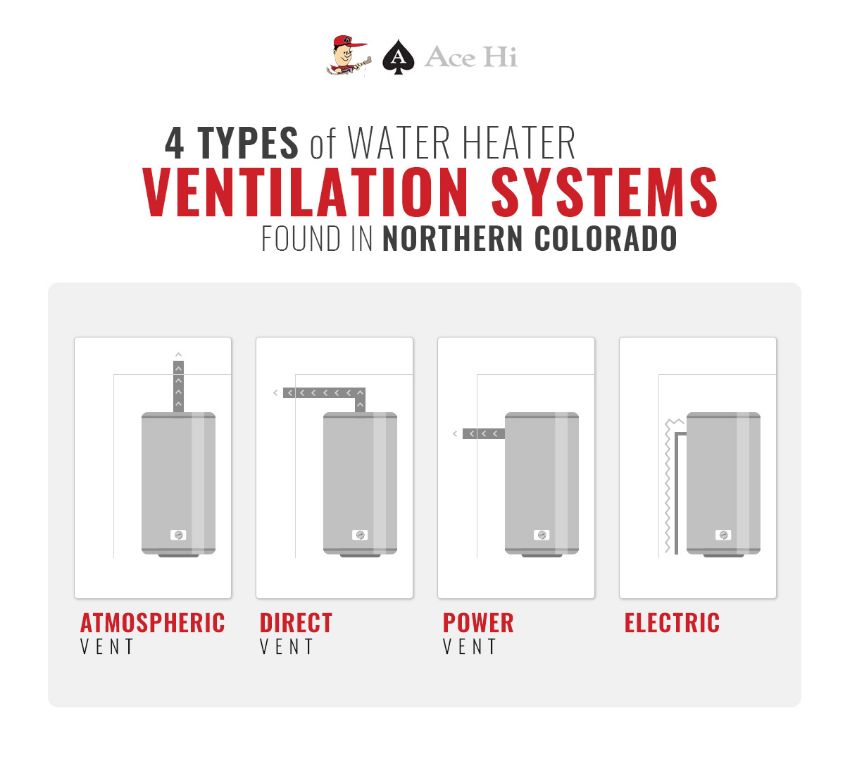A power vent on a hot water heater serves a very important purpose – it exhausts the products of combustion to the outdoors. By venting these gases outside, a power vent helps ensure the safe and efficient operation of the hot water heater.
Page Contents
How a Power Vent Works
A power vent uses a fan or blower to actively pull exhaust gases from the hot water heater and push them outside via a dedicated vent pipe. It provides positive pressure ventilation rather than relying on natural draft ventilation. The fan or blower turns on automatically when the burner fires up and shuts off when the burner turns off.
The power vent system consists of:
- A centrifugal fan or blower
- An exhaust vent pipe
- An air intake pipe
- Controls and sensors
When the water heater burner ignites, the power vent fan turns on. This creates suction that pulls exhaust gases in through the exhaust vent pipe. Fresh air is drawn in through the separate air intake pipe to replace the exhausted gases. The blower then pushes the exhaust gases out the termination point outside the home.
Advantages of a Power Vent
There are several key advantages to having a power vent on a hot water heater:
- Safety – By actively exhausting combustion gases outside, a power vent reduces the risk of carbon monoxide buildup in the home.
- Versatility – A power vent can be installed on virtually any type of fuel-fired water heater, including natural gas, propane, and oil-fired models.
- Flexible venting – A power vent can push exhaust through longer vent runs and a variety of vent configurations, allowing more flexible installation options.
- High efficiency – Power vented models have less wasted heat going up the flue, so more heat is transferred to the water. This makes them up to 15% more energy efficient.
- Better combustion – The positive pressure created by a power vent results in improved combustion efficiency and performance.
- Reduced condensation – The fan helps evaporate condensation in the vent pipe, reducing corrosion problems.
Types of Power Vents
There are two main types of power vents used on residential and commercial water heaters:
Centrifugal Fan Power Vents
This type of power vent uses a squirrel cage blower wheel to push exhaust gases through the vent system. The fan blade spins at high speeds, creating pressure to exhaust the gases. An electric motor drives the fan. Centrifugal power vents are common on many residential gas water heaters.
Inline Power Vents
Inline power vents utilize an axial fan that blows exhaust straight out through the vent pipe like a ducted fan. An electric motor or small turbine drives the fan blades. Inline vents take up less space and are well-suited for larger commercial and industrial water heaters.
Power Vent Controls
For proper and safe operation, a power vent requires various controls and sensors:
- Pressure switch – Senses negative pressure when the blower turns on and shuts off the burner if pressure is too low.
- Temp limit switch – Turns off the burner if flue gases get dangerously hot.
- Electronic control board – Receives signals from sensors and controls fan and burner operation.
- Exhaust temperature sensor – Monitors exhaust temperature and modulates the burner as needed.
- Airflow proving switch – Confirms there is adequate airflow before allowing burner ignition.
- Manual reset high limit – Shut off the burner completely if temperature or pressure exceed safe levels.
These controls form an integrated safety system to prevent hazards and ensure the power vent operates only when conditions are right for safe and efficient combustion.
Power Vent Maintenance
Like all components, power vents require periodic maintenance to keep operating reliably:
- Inspect the termination point outside annually and clear away any debris, snow or ice.
- Check rubber boots and sealing gaskets for any cracks or deterioration.
- Listen for abnormal noise like rattling which could indicate a failing motor.
- Clean the blower fan and motor compartment of any dust and dirt buildup.
- Make sure electrical connections are tight and wires are in good condition.
- Check pipe supports and hangers, tightening any that are loose.
Consult manufacturer guidelines for any specific maintenance recommendations. Following scheduled maintenance helps prevent problems and ensures the power vent functions safely for many years.
Conclusion
In summary, a power vent provides an active exhaust system to remove dangerous combustion gases from a hot water heater and vent them safely outside. Key benefits include enhanced safety, flexible venting options, high efficiency, and improved combustion performance. Regular maintenance helps keep power vents working properly. Overall, a power vent is a useful upgrade to any fuel-fired water heater installation.
